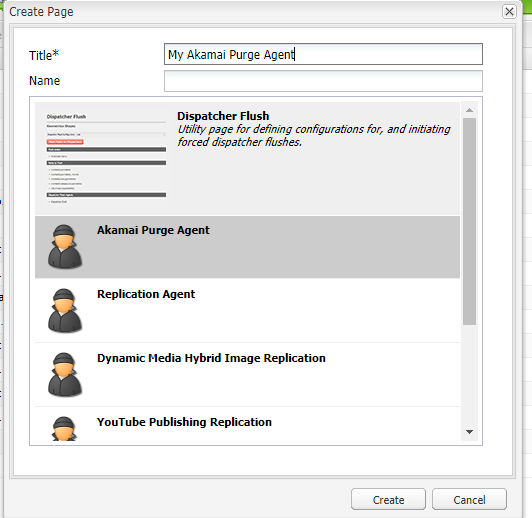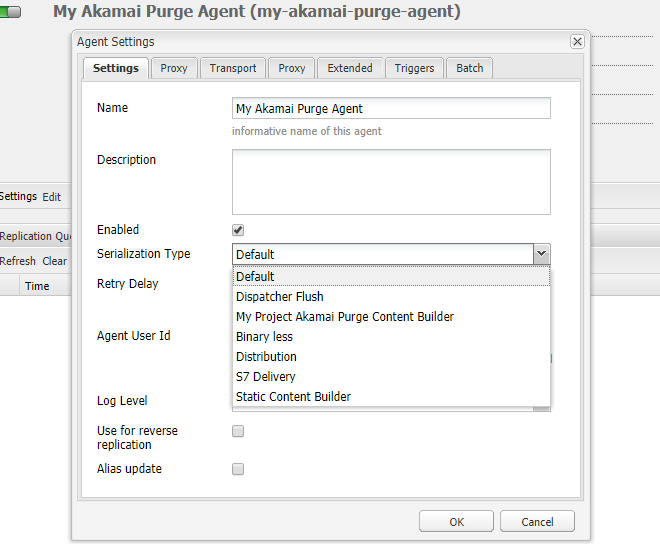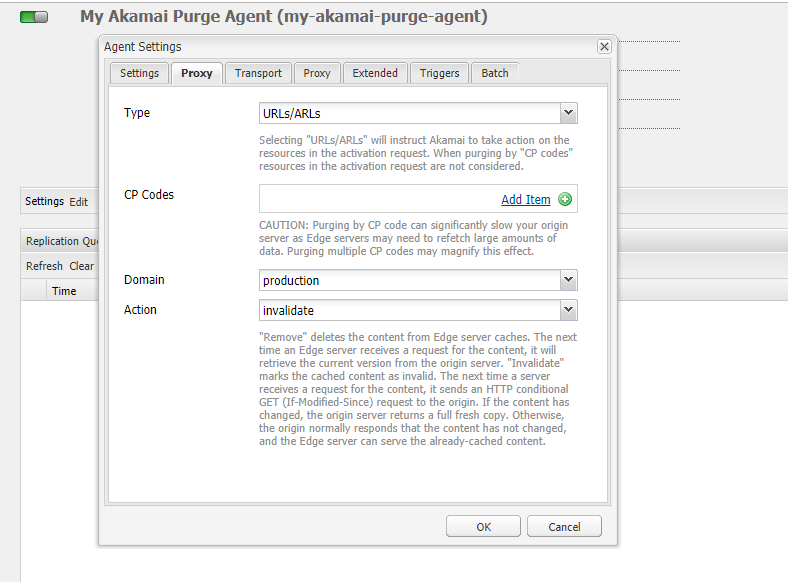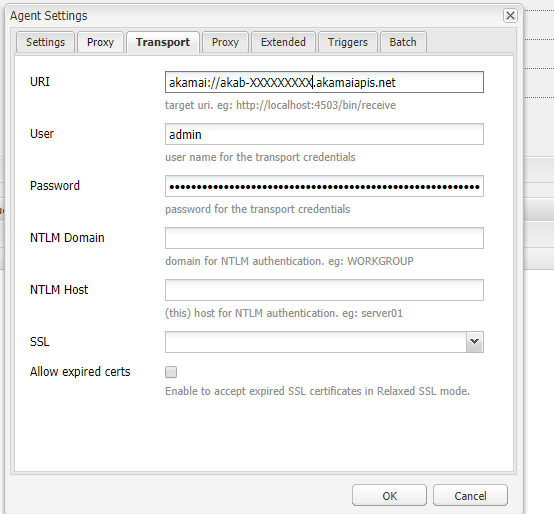REQUIREMENT: When a content author publishes/activates/replicates an item on AEM author that item should be immediately available on the live website, i.e. without having to explicitly request for a cache clear on the dispatcher and Akamai layers.
How to invalidate the dispatcher cache as soon as the item gets published?
We can achieve this by creating a Dispatcher flush Agent. You can refer doc from Adobe: https://docs.adobe.com/content/help/en/experience-manager-dispatcher/using/configuring/page-invalidate.html or you can follow the below blog: https://www.cqtutorial.com/courses/cq-admin/cq-admin-lessons/cq-dispatcher/cq-dispatcher-flush-agent-set-up
How to invalidate/clear the Akamai cache through Java code?
For this, we need to use Fast Purge API v3. This API helps purge content from your edge servers by URL, ARL, content provider (CP) code, or cache tag. However, currently for our case, we need to focus on purging content by URL only since we need to purge Akamai cache specifically for the pages that are published by the author.
Before beginning this process, you'll need a set of credentials that are generated through the Akamai Luna Control Center. This is done by browsing to the Configure -> Manage APIs -> Identity Management section of the Luna portal. Luna will provide you with the four pieces of credential and authorization information that you need to copy down: Client Token, Client Secret, Base URL, and Access Token. You can keep these values in an OSGi config file to retrieve them in our Akamai Purge Service. A sample OSGi config is shown below:

The following sample code demonstrates a custom replication agent that purges Akamai CDN (Content Delivery Network) cached content.
There are three aspects to this implementation: the transport handler, the content builder, and the replication agent.
1. Transport Handler: TransportHandler implementations control the communication with the destination server and determine when to report back a positive ReplicationResult to complete the activation and when to report back a negative ReplicationResult returning the activation to the queue. The transport handler service determines which transport handler to use based on the overridden canHandle method. A replication agent configured with a "Transport URI" that begins with http:// or https:// will be handled by AEM's HTTP transport handler. To customize it we need to create a unique custom URL protocol/scheme and have your transport handler's canHandle method watch for Transport URIs that start with your URL scheme. In this example, the transport handler is activated on the akamai:// scheme and uses the Akamai API Fast Purge API. (Few OOTB/default AEM replication agents use http://, static://, tnt://, s7delivery:// and repo:// schemes).
package com.myproject.bundle.core.services.impl;
import java.io.IOException;
import java.net.URI;
import java.nio.charset.Charset;
import org.apache.commons.io.IOUtils;
import org.apache.commons.lang3.StringUtils;
import org.apache.http.HttpStatus;
import org.apache.http.entity.ContentType;
import org.apache.jackrabbit.util.Base64;
import org.apache.sling.api.resource.ValueMap;
import org.apache.sling.commons.json.JSONArray;
import org.apache.sling.commons.json.JSONException;
import org.apache.sling.commons.json.JSONObject;
import org.apache.sling.commons.osgi.PropertiesUtil;
import org.osgi.service.component.annotations.Component;
import org.osgi.service.component.annotations.Reference;
import org.slf4j.Logger;
import org.slf4j.LoggerFactory;
import com.akamai.edgegrid.signer.ClientCredential;
import com.akamai.edgegrid.signer.exceptions.RequestSigningException;
import com.akamai.edgegrid.signer.googlehttpclient.GoogleHttpClientEdgeGridRequestSigner;
import com.day.cq.replication.AgentConfig;
import com.day.cq.replication.ReplicationActionType;
import com.day.cq.replication.ReplicationException;
import com.day.cq.replication.ReplicationResult;
import com.day.cq.replication.ReplicationTransaction;
import com.day.cq.replication.TransportContext;
import com.day.cq.replication.TransportHandler;
import com.myproject.bundle.core.configuration.BaseConfigurationService;
import com.myproject.bundle.core.constants.MyConstants;
import com.myproject.bundle.core.search.services.MyProjectConfigurationService;
import com.google.api.client.http.ByteArrayContent;
import com.google.api.client.http.GenericUrl;
import com.google.api.client.http.HttpHeaders;
import com.google.api.client.http.HttpRequest;
import com.google.api.client.http.HttpRequestFactory;
import com.google.api.client.http.HttpResponse;
import com.google.api.client.http.HttpTransport;
import com.google.api.client.http.apache.ApacheHttpTransport;
/**
* Transport handler to send test and purge requests to Akamai and handle
* responses. The handler sets up basic authentication with the user/pass from
* the replication agent's transport config and sends a GET request as a test
* and POST as purge request. A valid test response is 200 while a valid purge
* response is 201.
*
* The transport handler is triggered by setting your replication agent's
* transport URL's protocol to "akamai://".
*
* The transport handler builds the POST request body in accordance with
* Akamai's Fast Purge REST API {@link https://developer.akamai.com/api/core_features/fast_purge/v3.html}
* using the replication agent properties.
*/
@Component(service = TransportHandler.class, immediate = true)
public class AkamaiTransportHandler implements TransportHandler {
/**The Solr Server Configuration Service.*/
@Reference
MyProjectConfigurationService myProjectConfigurationService;
@Reference
BaseConfigurationService baseConfigurationService;
/**Logger Instantiation for Akamai Transport Handler*/
private static final Logger LOGGER = LoggerFactory.getLogger(AkamaiTransportHandler.class);
/** Protocol for replication agent transport URI that triggers this transport handler. */
private static final String AKAMAI_PROTOCOL = "akamai://";
/**Config Pid for Akamai Flush*/
private static final String AKAMAI_FLUSH_CONFIG_PID = "com.myproject.bundle.core.configuration.AkamaiFlushConfiguration";
/** Replication agent type property name. Valid values are "arl" and "cpcode". */
private static final String PROPERTY_AKAMAI_TYPE = "type";
/** Replication agent multifield CP Code property name.*/
private static final String PROPERTY_AKAMAI_CP_CODES = "4321xxx";
/** Replication agent domain property name. Valid values are "staging" and "production". */
private static final String PROPERTY_AKAMAI_DOMAIN = "domain";
/** Replication agent action property name. Valid values are "remove" and "invalidate". */
private static final String PROPERTY_AKAMAI_ACTION = "action";
/** Replication agent default type value */
private static final String PROPERTY_AKAMAI_TYPE_DEFAULT = "url";
/** Replication agent default domain value */
private static final String PROPERTY_AKAMAI_DOMAIN_DEFAULT = "production";
/** Replication agent default action value */
private static final String PROPERTY_AKAMAI_ACTION_DEFAULT = "invalidate";
/**Transport URI*/
private static final String TRANSPORT_URI = "transportUri";
/**
* {@inheritDoc}
*/
@Override
public boolean canHandle(AgentConfig config) {
final String transportURI = config.getTransportURI();
return (transportURI != null) && (transportURI.toLowerCase().startsWith(AKAMAI_PROTOCOL));
}
/**
* {@inheritDoc}
*/
@Override
public ReplicationResult deliver(TransportContext ctx, ReplicationTransaction tx)
throws ReplicationException {
final ReplicationActionType replicationType = tx.getAction().getType();
if (replicationType == ReplicationActionType.TEST) {
return ReplicationResult.OK;
} else if (replicationType == ReplicationActionType.ACTIVATE ||
replicationType == ReplicationActionType.DEACTIVATE ||
replicationType == ReplicationActionType.DELETE) {
LOGGER.info("Replication Type in Akamai Handler: {}", replicationType);
String resourcePath = tx.getAction().getPath();
if (StringUtils.startsWith(resourcePath, myProjectConfigurationService.getContentpath())
|| StringUtils.startsWith(resourcePath, myProjectConfigurationService.getAssetpath())) {
//checking for my project specific root page and root dam path.
LOGGER.info("Calling activate in Akamai for path: {}", resourcePath);
try {
return doActivate(ctx, tx);
} catch (RequestSigningException e) {
LOGGER.error("Signing ceremony unsuccessful....");
throw new ReplicationException("Signing ceremony unsuccessful: {}", e);
} catch (IOException e) {
LOGGER.error("IO Exception in deliver \n");
throw new ReplicationException("IO Exception in deliver: {}", e);
}
}
return ReplicationResult.OK;
} else {
throw new ReplicationException("Replication action type " + replicationType + " not supported.");
}
}
private String getTransportURI(TransportContext ctx) throws IOException {
LOGGER.info("Entering getTransportURI method.");
final ValueMap properties = ctx.getConfig().getProperties();
final String AKAMAI_HOST = baseConfigurationService.getPropValueFromConfiguration(AKAMAI_FLUSH_CONFIG_PID, "akamaiHost");
final String domain = PropertiesUtil.toString(properties.get(PROPERTY_AKAMAI_DOMAIN), PROPERTY_AKAMAI_DOMAIN_DEFAULT);
final String action = PropertiesUtil.toString(properties.get(PROPERTY_AKAMAI_ACTION), PROPERTY_AKAMAI_ACTION_DEFAULT);
final String type = PropertiesUtil.toString(properties.get(PROPERTY_AKAMAI_TYPE), PROPERTY_AKAMAI_TYPE_DEFAULT);
String defaultTransportUri = MyConstants.HTTPS + AKAMAI_HOST + "/ccu/v3/"
+ action + MyConstants.BACK_SLASH + type + MyConstants.BACK_SLASH + domain;
String transporturi = PropertiesUtil.toString(properties.get(TRANSPORT_URI), defaultTransportUri);
if(StringUtils.isEmpty(transporturi)) {
return defaultTransportUri;
}
if (transporturi.startsWith(AKAMAI_PROTOCOL)) {
transporturi = transporturi.replace(AKAMAI_PROTOCOL, MyConstants.HTTPS);
}
transporturi = transporturi + "/ccu/v3/"
+ action + MyConstants.BACK_SLASH + type + MyConstants.BACK_SLASH + domain;
LOGGER.info("Exiting getTransportURI method of Akamai Transport Handler : {}", transporturi);
return transporturi;
}
/**
* Send purge request to Akamai via a POST request
*
* Akamai will respond with a 201 HTTP status code if the purge request was
* successfully submitted.
*
* @param ctx Transport Context
* @param tx Replication Transaction
* @return ReplicationResult OK if 201 response from Akamai
* @throws ReplicationException
* @throws RequestSigningException
* @throws IOException
* @throws JSONException
*/
private ReplicationResult doActivate(TransportContext ctx, ReplicationTransaction tx)
throws ReplicationException, RequestSigningException, IOException {
LOGGER.info("Inside doActivate of Akamai");
final String AKAMAI_ACCESS_TOKEN = baseConfigurationService.getPropValueFromConfiguration(AKAMAI_FLUSH_CONFIG_PID, "akamaiAccessToken");
final String AKAMAI_CLIENT_TOKEN = baseConfigurationService.getPropValueFromConfiguration(AKAMAI_FLUSH_CONFIG_PID, "akamaiClientToken");
final String AKAMAI_CLIENT_SECRET = baseConfigurationService.getPropValueFromConfiguration(AKAMAI_FLUSH_CONFIG_PID, "akamaiClientSecret");
final String AKAMAI_HOST = baseConfigurationService.getPropValueFromConfiguration(AKAMAI_FLUSH_CONFIG_PID, "akamaiHost");
ClientCredential clientCredential = ClientCredential.builder().accessToken(AKAMAI_ACCESS_TOKEN).
clientToken(AKAMAI_CLIENT_TOKEN).clientSecret(AKAMAI_CLIENT_SECRET).host(AKAMAI_HOST).build();
HttpTransport httpTransport = new ApacheHttpTransport();
HttpRequestFactory httpRequestFactory = httpTransport.createRequestFactory();
JSONObject jsonObject = createPostBody(ctx, tx);
URI uri = URI.create(getTransportURI(ctx));
HttpRequest request = httpRequestFactory.buildPostRequest(new GenericUrl(uri), ByteArrayContent.fromString("application/json", jsonObject.toString()));
final HttpResponse response = sendRequest(request, ctx, clientCredential);
if (response != null) {
final int statusCode = response.getStatusCode();
LOGGER.info("Response code recieved: {}", statusCode);
if (statusCode == HttpStatus.SC_CREATED) {
return ReplicationResult.OK;
}
}
return new ReplicationResult(false, 0, "Replication failed");
}
/**
* Build preemptive basic authentication headers and send the request.
*
* @param request The request to send to Akamai
* @param ctx The TransportContext containing the username and password
* @return JSONObject The HTTP response from Akamai
* @throws ReplicationException if a request could not be sent
* @throws RequestSigningException
*/
private HttpResponse sendRequest(final HttpRequest request, final TransportContext ctx,
ClientCredential clientCredential)
throws ReplicationException, RequestSigningException {
LOGGER.info("Inside Send Request method of Akamai");
final String auth = ctx.getConfig().getTransportUser() + ":" + ctx.getConfig().getTransportPassword();
final String encodedAuth = Base64.encode(auth);
HttpHeaders httpHeaders = new HttpHeaders();
httpHeaders.setAuthorization("Basic " + encodedAuth);
httpHeaders.setContentType(ContentType.APPLICATION_JSON.getMimeType());
request.setHeaders(httpHeaders);
GoogleHttpClientEdgeGridRequestSigner requestSigner = new GoogleHttpClientEdgeGridRequestSigner(clientCredential);
requestSigner.sign(request);
HttpResponse response;
try {
response = request.execute();
} catch (IOException e) {
LOGGER.error("IO Exception in sendRequest");
throw new ReplicationException("Could not send replication request.", e);
}
LOGGER.info("Sucessfully executed Send Request for Akamai");
return response;
}
/**
* Build the Akamai purge request body based on the replication agent
* settings and append it to the POST request.
*
* @param request The HTTP POST request to append the request body
* @param ctx TransportContext
* @param tx ReplicationTransaction
* @throws ReplicationException if errors building the request body
*/
private JSONObject createPostBody(final TransportContext ctx,
final ReplicationTransaction tx) throws ReplicationException {
final ValueMap properties = ctx.getConfig().getProperties();
final String type = PropertiesUtil.toString(properties.get(PROPERTY_AKAMAI_TYPE), PROPERTY_AKAMAI_TYPE_DEFAULT);
JSONObject json = new JSONObject();
JSONArray purgeObjects = null;
if (type.equals(PROPERTY_AKAMAI_TYPE_DEFAULT)) {
try {
String content = IOUtils.toString(tx.getContent().getInputStream(), Charset.defaultCharset());
if (StringUtils.isNotBlank(content)) {
LOGGER.info("Content of Akamai is:\n {}", content);
purgeObjects = new JSONArray(content);
}
} catch (JSONException | IOException e) {
throw new ReplicationException("Could not retrieve content from content builder", e);
}
}
if (null != purgeObjects && purgeObjects.length() > 0) {
try {
json.put("objects", purgeObjects);
} catch (JSONException e) {
throw new ReplicationException("Could not build purge request content", e);
}
} else {
throw new ReplicationException("No CP codes or pages to purge");
}
return json;
}
}
<Import-Package>
javax.annotation;version=0.0.0,
</Import-Package>
<dependency>
<groupId>com.akamai.edgegrid</groupId>
<artifactId>edgegrid-signer-google-http-client</artifactId>
<version>4.0.0</version>
</dependency>
<dependency>
<groupId>com.akamai.edgegrid</groupId>
<artifactId>edgegrid-signer-core</artifactId>
<version>4.0.0</version>
</dependency>
<dependency>
<groupId>com.google.http-client</groupId>
<artifactId>google-http-client</artifactId>
<version>1.22.0</version>
</dependency>
<dependency>
<groupId>io.opencensus</groupId>
<artifactId>opencensus-api</artifactId>
<version>0.24.0</version>
</dependency>
<dependency>
<groupId>io.opencensus</groupId>
<artifactId>opencensus-contrib-http-util</artifactId>
<version>0.24.0</version>
</dependency>
<dependency>
<groupId>io.grpc</groupId>
<artifactId>grpc-context</artifactId>
<version>1.24.0</version>
</dependency>
2. Content Builder: ContentBuilder implementations build the body of the replication request. Implementations of the ContentBuilder interface end up as serialization options in the replication agent configuration dialog. While creating our custom replication agent, we will need to select the Serialization Type option as "My Project Akamai Purge Content Builder".
package com.myproject.bundle.core.services.impl;
import java.io.BufferedWriter;
import java.io.IOException;
import java.nio.charset.Charset;
import java.nio.file.Files;
import java.nio.file.Path;
import java.util.HashMap;
import java.util.Map;
import javax.jcr.Session;
import org.apache.commons.lang3.StringUtils;
import org.apache.sling.api.resource.LoginException;
import org.apache.sling.api.resource.Resource;
import org.apache.sling.api.resource.ResourceResolver;
import org.apache.sling.api.resource.ResourceResolverFactory;
import org.apache.sling.commons.json.JSONArray;
import org.apache.sling.jcr.resource.JcrResourceConstants;
import org.osgi.service.component.annotations.Component;
import org.osgi.service.component.annotations.Reference;
import org.slf4j.Logger;
import org.slf4j.LoggerFactory;
import com.day.cq.commons.Externalizer;
import com.day.cq.replication.ContentBuilder;
import com.day.cq.replication.ReplicationAction;
import com.day.cq.replication.ReplicationContent;
import com.day.cq.replication.ReplicationContentFactory;
import com.day.cq.replication.ReplicationException;
import com.day.cq.wcm.api.Page;
import com.day.cq.wcm.api.PageManager;
import com.myproject.bundle.core.constants.FsbpConstants;
import com.myproject.bundle.core.search.services.MyProjectConfigurationService;
/**
* Akamai content builder to create replication content containing a JSON array
* of URLs for Akamai to purge through the Akamai Transport Handler. This class
* takes the internal resource path and converts it to external URLs as well as
* adding vanity URLs and pages that may Sling include the activated resource.
*/
@Component(service = ContentBuilder.class,
property = {"name=myProjectAkamai", "value=akamai"},
immediate = true)
public class AkamaiContentBuilder implements ContentBuilder {
@Reference
private ResourceResolverFactory resolverFactory;
/** The name of the replication agent */
public static final String NAME = "myProjectAkamai";
/**
* The serialization type as it will display in the replication
* agent edit dialog selection field.
*/
public static final String TITLE = "My Project Akamai Purge Content Builder";
@Reference
MyProjectConfigurationService myProjectConfigurationService;
private static final Logger LOG = LoggerFactory.getLogger(AkamaiContentBuilder.class);
/**
* {@inheritDoc}
*/
@Override
public ReplicationContent create(Session session, ReplicationAction action,
ReplicationContentFactory factory) throws ReplicationException {
return create(session, action, factory, null);
}
/**
* Create the replication content containing the public facing URLs for
* Akamai to purge.
*/
@Override
public ReplicationContent create(Session session, ReplicationAction action,
ReplicationContentFactory factory, Map<String, Object> parameters)
throws ReplicationException {
final String path = action.getPath();
ResourceResolver resolver = null;
JSONArray jsonArray = new JSONArray();
if (StringUtils.isNotBlank(path)) {
HashMap<String, Object> sessionMap = new HashMap<>();
sessionMap.put(JcrResourceConstants.AUTHENTICATION_INFO_SESSION, session);
try {
resolver = resolverFactory.getResourceResolver(sessionMap);
if (StringUtils.contains(path, myProjectConfigurationService.getContentpath())) { // my project's specific page root path - /content/myproject
jsonArray = createPageContent(resolver, jsonArray, path);
} else if (StringUtils.contains(path, myProjectConfigurationService.getAssetpath())) { // my project's specific dam root path - /content/dam/myproject
jsonArray = createAssetContent(resolver, jsonArray, path);
}
} catch (LoginException e) {
LOG.error("Could not retrieve Page Manager", e);
}
return createContent(factory, jsonArray);
}
return ReplicationContent.VOID;
}
private JSONArray createPageContent(ResourceResolver resolver, JSONArray jsonArray, String path) {
PageManager pageManager = resolver.adaptTo(PageManager.class);
if (null != pageManager) {
Page purgedPage = pageManager.getContainingPage(path);
Externalizer externalizer = resolver.adaptTo(Externalizer.class);
if (null != purgedPage && null != externalizer) {
final String link = externalizer.externalLink(resolver, "firestonebpco", path);
jsonArray.put(link);
LOG.info("Page link added: {}", link);
final String vanityUrl = purgedPage.getVanityUrl();
if (StringUtils.isNotBlank(vanityUrl)) {
jsonArray.put(vanityUrl);
LOG.info("Vanity URL added: {}", vanityUrl);
}
} else {
jsonArray.put(path);
LOG.info("Page Resource path added: {}", path);
}
}
return jsonArray;
}
private JSONArray createAssetContent(ResourceResolver resolver, JSONArray jsonArray, String path) {
Resource purgedAssetResource = resolver.getResource(path);
Externalizer externalizer = resolver.adaptTo(Externalizer.class);
if (null != purgedAssetResource && null != externalizer) {
final String assetLink = externalizer.externalLink(resolver, "firestonebpco", path);
jsonArray.put(assetLink);
LOG.info("Asset link added: {}", assetLink);
} else {
jsonArray.put(path);
LOG.info("Asset Resource path added: {}", path);
}
return jsonArray;
}
/**
* Create the replication content containing
*
* @param factory Factory to create replication content
* @param jsonArray JSON array of URLS to include in replication content
* @return replication content
*
* @throws ReplicationException if an error occurs
*/
private ReplicationContent createContent(final ReplicationContentFactory factory,
final JSONArray jsonArray) throws ReplicationException {
Path tempFile;
try {
tempFile = Files.createTempFile("akamai_purge_agent", ".tmp");
} catch (IOException e) {
throw new ReplicationException("Could not create temporary file", e);
}
try (BufferedWriter writer = Files.newBufferedWriter(tempFile, Charset.forName("UTF-8"))) {
writer.write(jsonArray.toString());
writer.flush();
return factory.create("text/plain", tempFile.toFile(), true);
} catch (IOException e) {
throw new ReplicationException("Could not write to temporary file", e);
}
}
/**
* {@inheritDoc}
*
* @return {@value #NAME}
*/
@Override
public String getName() {
return NAME;
}
/**
* {@inheritDoc}
*
* @return {@value #TITLE}
*/
@Override
public String getTitle() {
return TITLE;
}
}
3. Replication Agent: Create a custom cq:Template as well as a corresponding cq:Component including the view and dialog. The easiest way to do this is to copy the default replication agent from /libs/cq/replication/templates/agent and /libs/cq/replication/components/agent to /apps/your-project/replication and update the agent like any other AEM component.
Our Akamai replication agent component inherits from the default replication agent by setting the sling:resourceSuperType to cq/replication/components/agent. The only update needed to the copied component is the dialog options and the agent.jsp file as it contains the JS code to open the dialog for which you need to update the path. ValueMap. Following is the agent.jsp and dialog.xml code:
<%@page session="false"%><%--
Copyright 1997-2009 Day Management AG
Barfuesserplatz 6, 4001 Basel, Switzerland
All Rights Reserved.
This software is the confidential and proprietary information of
Day Management AG, ("Confidential Information"). You shall not
disclose such Confidential Information and shall use it only in
accordance with the terms of the license agreement you entered into
with Day.
=================================================
Agent component
Displays information about a replication agent.
--%><%@page contentType="text/html"
pageEncoding="utf-8"
import="com.day.cq.replication.Agent,
com.day.cq.replication.AgentConfig,
com.day.cq.replication.AgentManager,
com.day.cq.replication.ReplicationQueue,
com.adobe.granite.ui.clientlibs.HtmlLibraryManager,
com.day.cq.i18n.I18n" %><%
%><%@include file="/libs/foundation/global.jsp"%><%
I18n i18n = new I18n(slingRequest);
String id = currentPage.getName();
String title = properties.get("jcr:title", id); // user generated content, no i18n
AgentManager agentMgr = sling.getService(AgentManager.class);
Agent agent = agentMgr.getAgents().get(id);
AgentConfig cfg = agent == null ? null : agent.getConfiguration();
if (cfg == null || !cfg.getConfigPath().equals(currentNode.getPath())) {
// agent not active
agent = null;
}
// get icons
String globalIcnCls = "cq-agent-header";
String statusIcnCls = "cq-agent-status";
if (agent == null) {
statusIcnCls += "-inactive";
globalIcnCls += "-off";
} else {
try {
agent.checkValid();
if (agent.isEnabled()) {
globalIcnCls += "-on";
statusIcnCls += "-ok";
} else {
globalIcnCls += "-off";
statusIcnCls += "-disabled";
}
} catch (IllegalArgumentException e) {
globalIcnCls += "-off";
statusIcnCls += "-invalid";
}
}
%><!DOCTYPE html PUBLIC "-//W3C//DTD XHTML 1.0 Transitional//EN">
<html>
<head>
<title><%= i18n.get("AEM Replication") %> | <%= xssAPI.encodeForHTML(title) %></title>
<meta http-equiv="Content-Type" content="text/html; charset=utf-8" />
<%
HtmlLibraryManager htmlMgr = sling.getService(HtmlLibraryManager.class);
if (htmlMgr != null) {
htmlMgr.writeIncludes(slingRequest, out, "cq.wcm.edit", "cq.replication");
}
%>
<script src="/libs/cq/ui/resources/cq-ui.js" type="text/javascript"></script>
</head>
<body>
<h2 class="<%= globalIcnCls %>"><%= xssAPI.encodeForHTML(title) %> (<%= xssAPI.encodeForHTML(id) %>)</h2>
<%
String description = properties.get("jcr:description", ""); // user generated content, no i18n
%><p><%= xssAPI.encodeForHTML(description) %></p><%
%><div id="agent-details" class="cq-replication-agent-details"><cq:include path="<%= xssAPI.encodeForHTMLAttr(resource.getPath()) + ".details.html" %>" resourceType="<%= xssAPI.encodeForHTMLAttr(resource.getResourceType()) %>"/></div>
<div>
<br>
<%
// draw the 'edit' bar explicitly. since we want to be able to edit the
// settings on publish too. we are too late here for setting the WCMMode.
/*
out.flush();
if (editContext != null) {
editContext.getEditConfig().getToolbar().add(0, new Toolbar.Label("Settings"));
editContext.includeEpilog(slingRequest, slingResponse, WCMMode.EDIT);
}
*/
%>
<script type="text/javascript">
CQ.WCM.edit({
"path":"<%= xssAPI.encodeForHTML(resource.getPath()) %>",
"dialog":"/apps/fsbp/components/content/agent/dialog",
"type":"fsbp/components/content/agent",
"editConfig":{
"xtype":"editbar",
"listeners":{
"afteredit":"REFRESH_PAGE"
},
"inlineEditing":CQ.wcm.EditBase.INLINE_MODE_NEVER,
"disableTargeting": true,
"actions":[
{
"xtype":"tbtext",
"text":"Settings"
},
CQ.wcm.EditBase.EDIT
]
}
});
</script>
</div>
<%
if (agent != null) {
%>
<div id="CQ">
<div id="cq-queue">
</div>
</div>
<script type="text/javascript">
function reloadDetails() {
var url = CQ.HTTP.externalize("<%= xssAPI.encodeForHTML(currentPage.getPath()) %>.details.html");
var response = CQ.HTTP.get(url);
if (CQ.HTTP.isOk(response)) {
document.getElementById("agent-details").innerHTML = response.responseText;
}
}
CQ.Ext.onReady(function(){
var queue = new CQ.wcm.ReplicationQueue({
url: "<%= xssAPI.encodeForHTML(currentPage.getPath()) %>/jcr:content.queue.json",
applyTo: "cq-queue",
height: 400
});
queue.on("afterrefresh", function(queue) {
reloadDetails();
});
queue.on("aftercleared", function(queue) {
reloadDetails();
});
queue.on("afterretry", function(queue) {
reloadDetails();
});
queue.loadAgent("<%= xssAPI.encodeForHTML(id) %>");
});
function test() {
CQ.shared.Util.open(CQ.HTTP.externalize('<%= xssAPI.encodeForHTML(currentPage.getPath()) %>.test.html'));
}
</script>
<%
} // if (agent != null)
%>
</body>
</html>
<?xml version="1.0" encoding="UTF-8"?>
<jcr:root xmlns:cq="http://www.day.com/jcr/cq/1.0" xmlns:jcr="http://www.jcp.org/jcr/1.0"
jcr:primaryType="cq:Dialog"
height="512"
title="Agent Settings">
<items jcr:primaryType="cq:WidgetCollection">
<tabs jcr:primaryType="cq:TabPanel">
<items jcr:primaryType="cq:WidgetCollection">
<tab1
jcr:primaryType="cq:Widget"
path="/libs/cq/replication/components/agent/tab_agent.infinity.json"
xtype="cqinclude"/>
<tabAkamai
jcr:primaryType="cq:Widget"
path="/apps/fsbp/components/content/agent/tab_akamai.infinity.json"
xtype="cqinclude"/>
<tab2
jcr:primaryType="cq:Widget"
path="/libs/cq/replication/components/agent/tab_transport.infinity.json"
xtype="cqinclude"/>
<tab3
jcr:primaryType="cq:Widget"
path="/libs/cq/replication/components/agent/tab_proxy.infinity.json"
xtype="cqinclude"/>
<tab4
jcr:primaryType="cq:Widget"
path="/libs/cq/replication/components/agent/tab_extended.infinity.json"
xtype="cqinclude"/>
<tab5
jcr:primaryType="cq:Widget"
path="/libs/cq/replication/components/agent/tab_triggers.infinity.json"
xtype="cqinclude"/>
<tab6
jcr:primaryType="cq:Widget"
path="/libs/cq/replication/components/agent/tab_batch.infinity.json"
xtype="cqinclude"/>
</items>
</tabs>
</items>
</jcr:root>
tab_akami.xml:
<?xml version="1.0" encoding="UTF-8"?>
<jcr:root xmlns:cq="http://www.day.com/jcr/cq/1.0" xmlns:jcr="http://www.jcp.org/jcr/1.0" xmlns:nt="http://www.jcp.org/jcr/nt/1.0"
jcr:primaryType="cq:Panel"
title="Proxy">
<items jcr:primaryType="cq:WidgetCollection">
<type
jcr:primaryType="cq:Widget"
defaultValue="arl"
fieldDescription="Selecting &quot;URLs/ARLs&quot; will instruct Akamai to take action on the resources in the activation request. When purging by &quot;CP codes&quot; resources in the activation request are not considered."
fieldLabel="Type"
name="./type"
type="select"
xtype="selection">
<options jcr:primaryType="cq:WidgetCollection">
<url
jcr:primaryType="nt:unstructured"
text="URLs/ARLs"
value="url"/>
<cpcode
jcr:primaryType="nt:unstructured"
text="CP codes"
value="cpcode"/>
</options>
</type>
<cpCodes
jcr:primaryType="cq:Widget"
fieldDescription="CAUTION: Purging by CP code can significantly slow your origin server as Edge servers may need to refetch large amounts of data. Purging multiple CP codes may magnify this effect."
fieldLabel="CP Codes"
name="./akamaiCPCodes"
xtype="multifield"/>
<domain
jcr:primaryType="cq:Widget"
defaultValue="production"
fieldLabel="Domain"
name="./domain"
type="select"
xtype="selection">
<options jcr:primaryType="cq:WidgetCollection">
<production
jcr:primaryType="nt:unstructured"
text="production"
value="production"/>
<staging
jcr:primaryType="nt:unstructured"
text="staging"
value="staging"/>
</options>
</domain>
<action
jcr:primaryType="cq:Widget"
defaultValue="remove"
fieldDescription="&quot;Remove&quot; deletes the content from Edge server caches. The next time an Edge server receives a request for the content, it will retrieve the current version from the origin server. &quot;Invalidate&quot; marks the cached content as invalid. The next time a server receives a request for the content, it sends an HTTP conditional GET (If-Modified-Since) request to the origin. If the content has changed, the origin server returns a full fresh copy. Otherwise, the origin normally responds that the content has not changed, and the Edge server can serve the already-cached content."
fieldLabel="Action"
name="./action"
type="select"
xtype="selection">
<options jcr:primaryType="cq:WidgetCollection">
<remove
jcr:primaryType="nt:unstructured"
text="remove"
value="delete"/>
<invalidate
jcr:primaryType="nt:unstructured"
text="invalidate"
value="invalidate"/>
</options>
</action>
</items>
</jcr:root>

Now configure your Replication Agent. Select "My Project Akamai Purge Content Builder" from the Serialization dropdown.

Configure other tabs as shown below:

Configure the URL in the Transport tab starting with "akamai://" (we provided in AkamaiTransportHandler.java code) followed by the base URL that we got at the beginning (also present in the config file as akamaiHost field).


No comments:
Post a Comment
If you have any doubts or questions, please let us know.